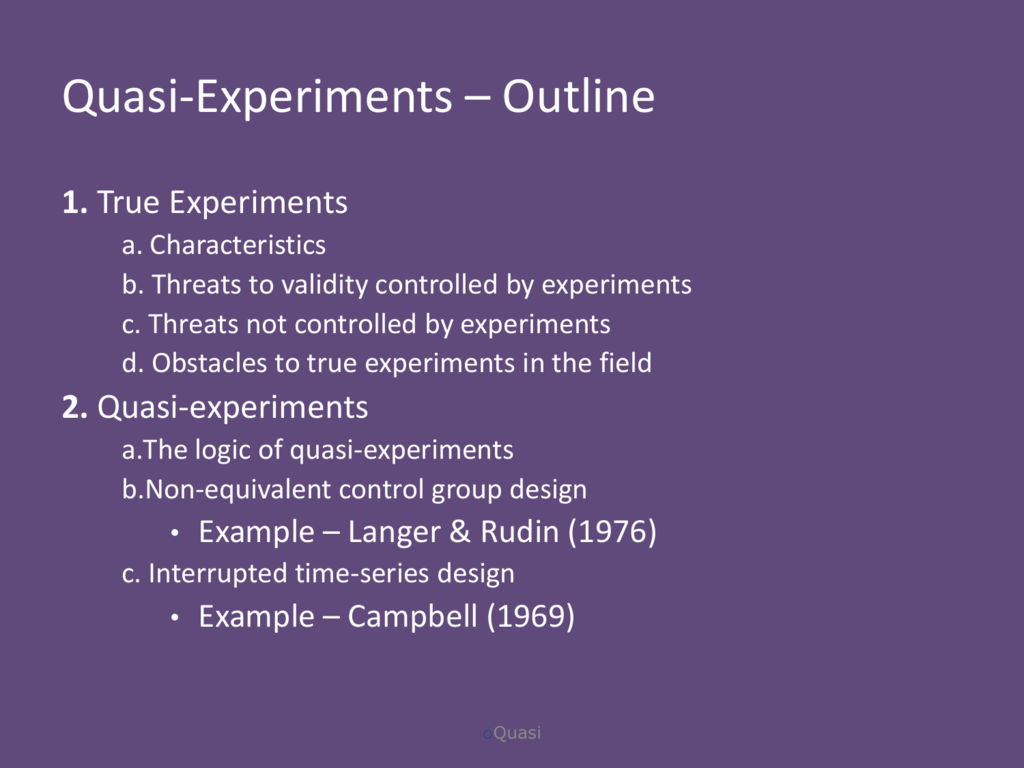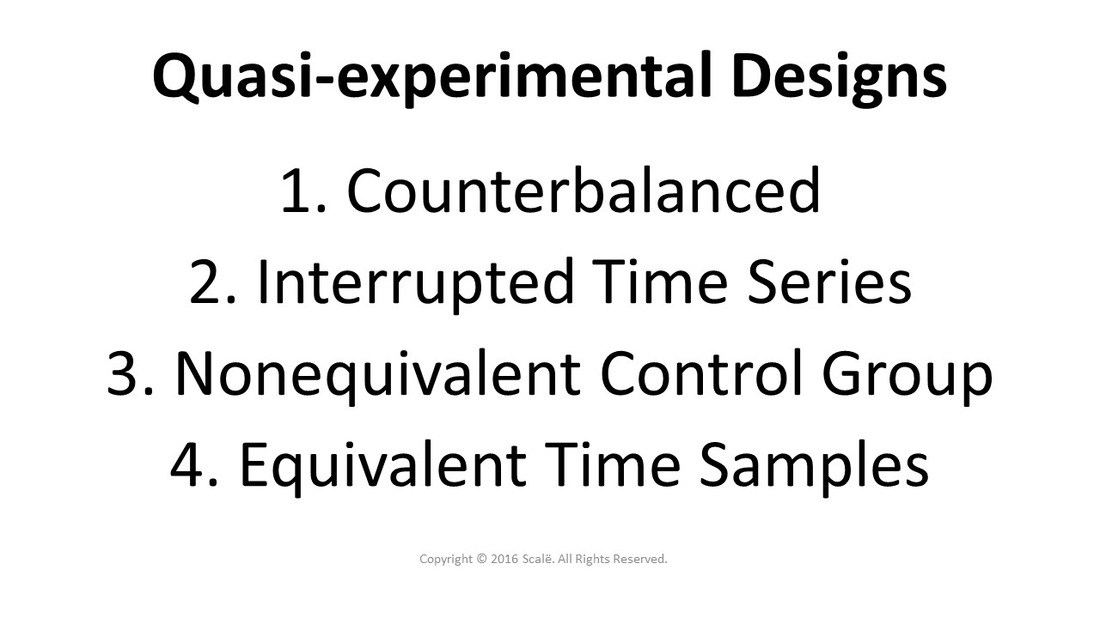Table Of Content
- Quasi-experimental Designs without Control Groups
- Turn Your Data Into Easy-To-Understand And Dynamic Stories
- The Manipulation of Predictor Variables
- Quasi-Experimental Research Design – Types, Methods
- Example 2: Determining the effectiveness of teaching modern leadership techniques in start-up businesses

A group of severely depressed people today is likely to be less depressed on average in 6 months. In reviewing the results of several studies of treatments for depression, researchers Michael Posternak and Ivan Miller found that participants in waitlist control conditions improved an average of 10 to 15% before they received any treatment at all (Posternak & Miller, 2001)[2]. Thus one must generally be very cautious about inferring causality from pretest-posttest designs. Another alternative explanation for a change in the dependent variable in a pretest-posttest design is regression to the mean.
Quasi-experimental Designs without Control Groups
For example, a cohort study can study intervention and comparator groups concurrently, with information about the intervention and comparator collected prospectively (PCS) or retrospectively (RCS), or study one group retrospectively and the other group prospectively (HCS). These different kinds of cohort study are conventionally distinguished according to the time when intervention and comparator groups are formed, in relation to the conception of the study. Some studies are sometimes incorrectly termed PCS, in our view, when data are collected prospectively, for example, for a clinical database, but when definitions of intervention and comparator required for the evaluation are applied retrospectively; in our view, this should be an RCS.
Turn Your Data Into Easy-To-Understand And Dynamic Stories
This question avoids the need for separate checklists for designs based on assigning individual and clusters. A “yes” response can be given to more than one response item; the different types clustering may both occur in a single study and implicit clustering can occur an individually allocated nonrandomized study. Researchers interested in studying the impact of a public health campaign aimed at reducing smoking rates may take advantage of a natural experiment. By comparing smoking rates in a region that has implemented the campaign to a similar region that has not, researchers can examine the effectiveness of the intervention. Imagine a study aiming to determine the effectiveness of math apps in supplementing traditional math classes in a school. Randomly assigning students to different groups might be impractical or disrupt the existing classroom structure.

The Manipulation of Predictor Variables
Regression to the mean all but guarantees that their scores will be higher even if the training program has no effect. A closely related concept—and an extremely important one in psychological research—is spontaneous remission. This is the tendency for many medical and psychological problems to improve over time without any form of treatment. If one were to measure symptom severity in 100 common cold sufferers today, give them a bowl of chicken soup every day, and then measure their symptom severity again in a week, they would probably be much improved. This does not mean that the chicken soup was responsible for the improvement, however, because they would have been much improved without any treatment at all.

The authors administered a 50-question survey to participants and non-participants within 72 hours of the program start (pre-survey) and end (post-survey). The survey questions assessed financial knowledge, financial satisfaction, money beliefs, and money behaviors. The authors conducted statistical analyses to compare differences in outcomes between program participants and non-participants. Question 1 is new and addresses the issue of clustering, either by design or through the organizational structure responsible for delivering the intervention (Box 3).
Research Methods in Psychology – 2nd Canadian Edition
Using the precaution adoption process model and the health belief model to understand radon testing and mitigation: a ... - BMC Public Health
Using the precaution adoption process model and the health belief model to understand radon testing and mitigation: a ....
Posted: Fri, 19 May 2023 07:00:00 GMT [source]
These quasi-experimental designs offer researchers flexible alternatives to traditional experiments, allowing exploration of cause-and-effect relationships in various contexts. This design utilizes a cutoff point or threshold to determine which participants receive the treatment or intervention. It assumes that participants on either side of the cutoff are similar in all other aspects, except for their exposure to the independent variable. At this design stage, the first step at improving internal validity would be focused on selection of a non-equivalent control group(s) for which some balance in the distribution of known risk factors is established. This can be challenging as there may not be adequate information available to determine how ‘equivalent’ the comparison group is regarding relevant covariates. This means that each person has an equivalent chance of being assigned to the experimental group or the control group, depending on whether they are manipulated or not.
In our view, these labels obscure some of the detailed features of the study designs that affect the robustness of causal attribution. A type of quasi-experimental design that is generally better than either the nonequivalent groups design or the pretest-posttest design is one that combines elements of both. There is a treatment group that is given a pretest, receives a treatment, and then is given a posttest. But at the same time there is a control group that is given a pretest, does not receive the treatment, and then is given a posttest. The question, then, is not simply whether participants who receive the treatment improve but whether they improve more than participants who do not receive the treatment. A single pretest measurement is taken (O1), an intervention (X) is implemented, and a posttest measurement is taken (O2).
An example comparing a true experiment and quasi-experiment
The comparison group consisted of non-participants identified by employers and received a financial education booklet in lieu of classes. The comparison group consisted of 56 employees, 7 from Company A and 49 from Company B. The study sample was predominantly female, and a plurality of employees had incomes between $38,521 and $101,582. However, the comparison group members had a lower percentage of bachelor’s degree recipients than the program group. There are certain situations where the use of a quasi-experimental design is more suited to the study. This is especially true for studies where it would be unethical to withhold treatment from a subject on a random basis. In such situations, researchers can utilize quasi-experimental design to circumvent any ethical issues.
To get the true effect of the intervention of interest, we need to control for the confounding variable. Consider a study evaluating the effectiveness of teaching modern leadership techniques in start-up businesses. Instead of artificially assigning businesses to different groups, researchers can observe those that naturally adopt modern leadership techniques and compare their outcomes to those of businesses that have not implemented such practices. Consequently, it is easier to estimate the true effect of the variable of interest on the outcome of interest. Quasi-experimental research compares groups with different circumstances or treatments to find cause-and-effect links.
The study by Grant et al et al uses a variant of the SWD for which individuals within a setting are enumerated and then randomized to get the intervention. Individuals contributed follow-up time to the “pre-clinic” phase from the baseline date established for the cohort until the actual date of their first clinic visit, and also to the “post- clinic” phase thereafter. Studies using a wait-list partial randomization design are also included in Table 2 (24, 27, 42). These types of studies are well-suited to settings where there is routine enumeration of a cohort based on a specific eligibility criteria, such as enrolment in a health plan or employment group, or from a disease-based registry, such as for diabetes (27, 42). It has also been reported that this design can increase efficiency and statistical power in contrast to cluster-based trials, a crucial consideration when the number of participating individuals or groups is small (22). The true experimental design may be impossible to accomplish or just too expensive, especially for researchers with few resources.
Health systems researchers and health economists use a wide range of “quasi-experimental” approaches to estimate causal effects of health care interventions. In the present context, they are considered to use rigorous designs and methods of analysis which can enable studies to adjust for unobservable sources of confounding [6] and are identical to the union of “strong” and “weak” quasi-experiments as defined by Rockers et al. [4]. Quasi-experimental research designs are research methodologies that resemble true experiments but lack the randomized assignment of participants to groups. In a true experiment, researchers randomly assign participants to either an experimental group or a control group, allowing for a comparison of the effects of an independent variable on the dependent variable.
Researchers typically employ it when evaluating policy or educational interventions, or in medical or therapy scenarios. This method involves using statistical tests to determine whether the results of a study are statistically significant. Inferential statistics can help researchers make generalizations about a population based on the sample data collected during the study.
The researchers might also manipulate the value of the child care subsidies in order to determine if higher subsidy values might result in different levels of maternal employment. You can use two-group tests, time-series analysis, and regression analysis to analyze data in a quasi-experiment design. In a true experiment, some participants would eat junk foods, while the rest would be in the control group, adhering to a regular diet. Recruiting participants and properly designing a data-collection attribute to make the research a true experiment requires a lot of time and effort, and can be expensive if you don’t have a large funding stream. This design involves measuring the dependent variable(s) before and after an intervention or event, but without a control group.
Interprofessional communication skills training to improve medical students' and nursing trainees' error communication ... - BMC Medical Education
Interprofessional communication skills training to improve medical students' and nursing trainees' error communication ....
Posted: Wed, 03 Jan 2024 08:00:00 GMT [source]
This design also aims to uncover cause-and-effect relationships between variables, but it assigns participants to groups using non-random criteria. Think of quasi-experimental design as a clever way scientists investigate cause and effect without the strict rules of a lab. Instead of assigning subjects randomly, researchers work with what they’ve got, making it more practical for real-world situations.
However, a number of important confounding variables, such as severity of illness and knowledge of software users, might affect both outcome measures. Thus, if the average length of stay did not change following the intervention but pharmacy costs did, then the data are more convincing than if just pharmacy costs were measured. Quasi-experiments are studies that aim to evaluate interventions but that do not use randomization. Similar to randomized trials, quasi-experiments aim to demonstrate causality between an intervention and an outcome.
In order to assure subject safety, all researchers should have their project reviewed by the Institutional Review Boards (IRBS). True experiments, in which all the important factors that might affect the phenomena of interest are completely controlled, are the preferred design. Often, however, it is not possible or practical to control all the key factors, so it becomes necessary to implement a quasi-experimental research design. In a classic 1952 article, researcher Hans Eysenck pointed out the shortcomings of the simple pretest-posttest design for evaluating the effectiveness of psychotherapy.

No comments:
Post a Comment